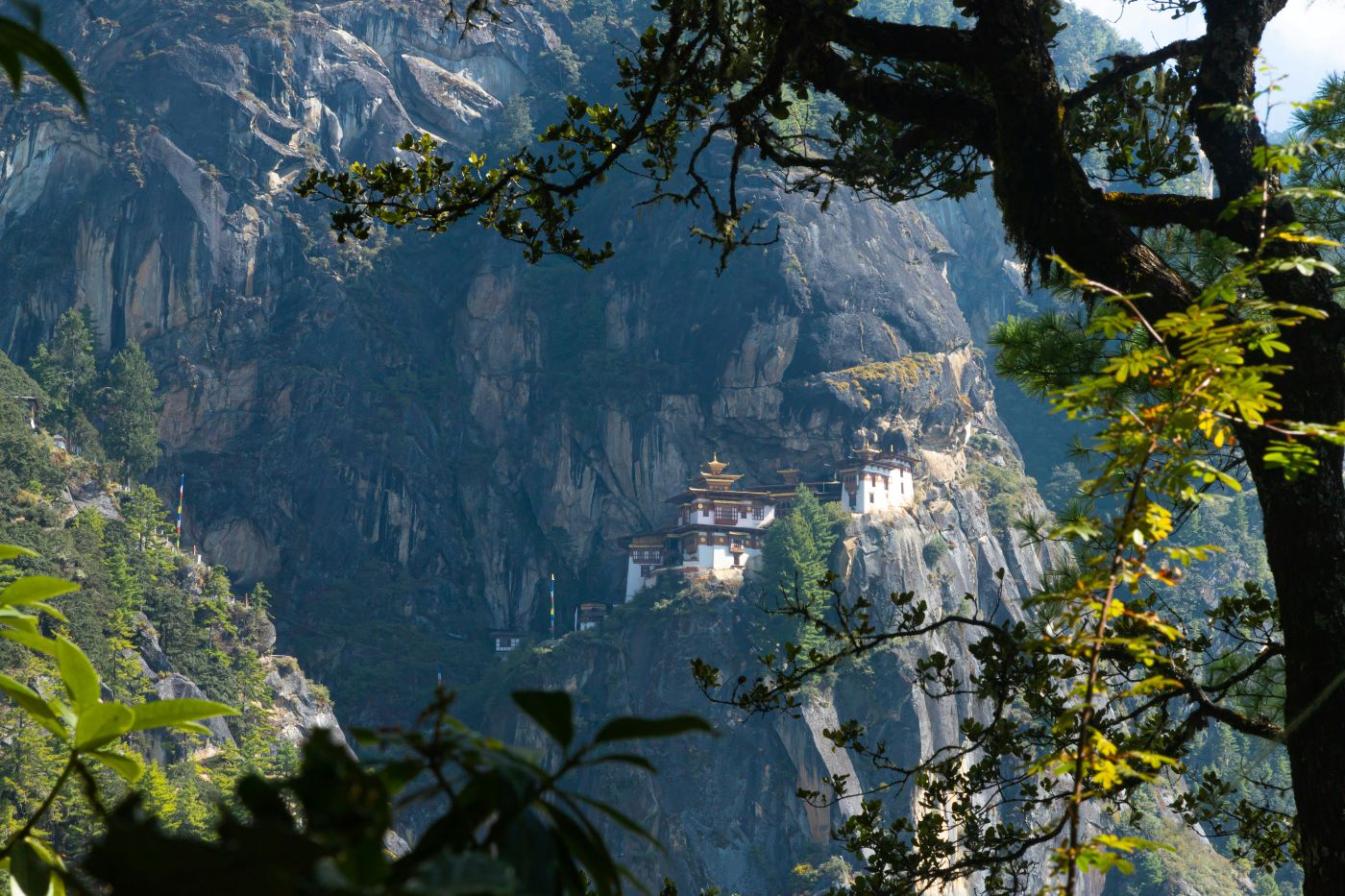Nine hundred meters above the valley floor, clinging to a sheer vertical face of black granite, hangs a structure that defies the logic of architecture and the laws of gravity. Through the shifting Himalayan mists, it appears intermittently—a white honeycomb cemented not by mortar, but by sheer spiritual will, onto the precipice. This is Paro Taktsang, known to the world as the Tiger’s Nest.
From the ground, the monastery does not look like a building; it looks like a hallucination. The clouds often sever the rock face, making the white walls and golden roofs appear to float in the ether, untethered to the earth. It is a sight that induces a specific kind of vertigo, one that is as much spiritual as it is physical. This is not merely a temple; it is a celestial citadel, a borderland where the mundane world of gravity ends and the esoteric world of the mythology of Bhutan begins.
In the thin air of the Himalayas, the distinction between rock and legend blurs. The granite is not just stone; it is the frozen flesh of demons. The wind is not just weather; it is the breath of deities. To approach the Tiger’s Nest is to enter a narrative that has been written in stone and spirit for over a millennia, a story of a flying tigress, a wrathful sorcerer, and a battle for the soul of the Himalayas.
The Flight of the Tigress
The origins of Paro Taktsang are not found in architectural blueprints, but in the Tiger’s Nest Monastery legends that form the bedrock of Bhutanese Buddhism. The history of this site begins in the 8th century, a time when the Himalayas were a wild frontier dominated by animistic spirits and malevolent forces.
Enter Guru Rinpoche (Padmasambhava), the "Precious Master," the second Buddha who brought Vajrayana Buddhism to the Himalayas. Unlike the founders of other faiths who might have arrived on foot or in humble caravans, the legend dictates that Guru Rinpoche arrived by air.
He did not fly on a cloud or a chariot, but on the back of a flying tigress.
This tigress was no ordinary beast. She was the manifestation of Yeshe Tsogyal, the Guru's primary consort and a powerful enlightened being in her own right. In a supreme act of devotion and magical transformation, she shed her human form to become the Yeshe Tsogyal tigress—a vessel of terrifying power and grace. Together, they flew from Khenpajong in Tibet to this precise, terrifying cliff in Paro.
The image of the Lotus-Born Guru riding a tigress into the clouds is the central icon of the site. It sets the tone for everything that follows: this is a place reached only by transcending the physical limitations of the human body. The tigress landed on the narrow ledge of the cliff, a spot where no human could stand, claiming the mountain not through negotiation, but through the sheer dominance of the miraculous.
The Demon of the Valley: Singye Samdrup
Why land on a sheer cliff face? Why build a sanctuary in a place so hostile to life?
The answer lies in the antagonist of the legend: Singye Samdrup. In the 8th century, the Paro valley was not the peaceful agrarian landscape it is today. It was the domain of Singye Samdrup, a powerful local demon who terrorized the inhabitants, spreading disease, discord, and misfortune. The demon’s influence was heavy, a spiritual miasma that choked the valley.
Guru Rinpoche did not come to Paro to meditate in peace; he came to wage war. The cliff of Taktsang was identified as the heart of the demon’s territory, the strategic high ground from which the entity could be confronted. The monastery, therefore, was not conceived as a retreat. It was established as a fortress, a spiritual forward operating base planted directly in the face of the enemy.
The legend tells us that the Guru subdued the demon not by destroying him, but by binding him to the Dharma. Singye Samdrup was converted into a protector deity, sworn to defend the very faith he once opposed. This theme of transmutation—turning poison into medicine, enemies into protectors—is central to the Paro Taktsang history.
Dorje Drolo: The Wrathful Form
To conquer a demon as powerful as Singye Samdrup, Guru Rinpoche could not appear in his peaceful form. The situation required "Crazy Wisdom"—a chaotic, fierce energy capable of shattering the ego and subduing malevolence.
It was here, in the caves of Taktsang, that the Guru assumed one of his Eight Manifestations: the Dorje Drolo wrathful form. In Buddhist iconography, Dorje Drolo is depicted as a terrifying figure. He is red, wreathed in flames, with three glaring eyes and fangs bared, riding a pregnant tigress. He holds a vajra (thunderbolt) in one hand and a phurba (ritual dagger) in the other.
This imagery is vital for the visitor to understand. The Tiger’s Nest is often romanticized by Western travelogues as a place of Zen-like calm. In reality, its spiritual foundation is violent and incendiary. It is a place where the "Thunderbolt Way" (Vajrayana) struck the mountain. The energy of the site is the energy of a spiritual cataclysm, a place where the Guru stood wreathed in fire to scream defiance at the darkness.
The Cave of the Eight Manifestations
Behind the whitewashed walls of the monastery complex lies the true heart of the site: the Pelphug, or the cave where the Guru meditated.
After his arrival on the tigress, Guru Rinpoche sequestered himself in this cave. The duration of his meditation is cited with precise numerological significance: three years, three months, three weeks, three days, and three hours. This sequence represents the purification of the subtle channels and energies within the body, a complete cycle of transformation.
The cave is small, dark, and damp. The rock walls press in, creating a sensation of intense compression. It is said that the Guru’s meditation was so profound that he left an imprint of his body in the stone wall, a "body print" that pilgrims still strain to see in the gloom. This cave is the "womb" of Bhutanese Buddhism. From this dark, pressurized hole in the rock, the light of the Dharma radiated out to cover the entire country. It is the cave of the eight manifestations, the crucible where the spiritual destiny of the nation was forged.
Architecture of the Abyss: Defying Physics
The structure that currently stands on the site is a masterpiece of Bhutanese architecture, but it is also a defiance of physics. Built in 1692 by Gyalse Tenzin Rabgye (believed to be a reincarnation of Guru Rinpoche), the complex clings to the rock face like a swallow’s nest.
There are no steel girders, no concrete anchors deep into the bedrock. The monastery consists of four main temples and residential shelters designed to adapt to the vertical topography. The buildings are interconnected by a series of stone staircases and narrow wooden balconies that hang precariously over the void.
Walking along these balconies creates a sense of "spiritual vertigo." The wooden floorboards offer glimpses of the 900-meter drop below. The wind howls through the corridors, rattling the prayer wheels and snapping the prayer flags. It is a constant reminder of the fragility of the structure and the power of the element. The architecture forces a confrontation with fear; to walk here is to trust that the mountain will hold you, just as it holds the temples.
Fire on the Mountain: The 1998 Inferno
The impermanence of all things is a central tenet of Buddhism, and Paro Taktsang has not been spared this lesson. On April 19, 1998, a tragedy struck that shook the nation of Bhutan to its core. A fire, likely started by an overturned butter lamp, raged through the main building.
Because of the monastery’s inaccessible location, modern firefighting equipment could not be brought to the site. The people of the valley could only watch helplessly from below as their holiest site was consumed by flames. The fire destroyed the main structure, claiming the life of a monk and incinerating centuries-old paintings, statues, and scriptures.
When the smoke cleared, only a "blackened tooth" of the mountain remained. The loss was not just architectural; it was a soul-wound for the country. The King of Bhutan commanded immediate restoration, but the process was an agonizing feat of human endurance.
The Penance of Rebuilding
The reconstruction of Paro Taktsang was a crusade of devotion. With no roads, every bag of cement, every slate for the roof, every timber beam, and every gold-plated statue had to be carried up the mountain by hand or on the backs of horses.
Workers balanced on bamboo scaffolding over the abyss to lay the stones. The rebuilding became a national act of penance and merit-making. It took nearly seven years to restore the monastery to its former glory. What stands today is indistinguishable from the original to the untrained eye, yet it is a resurrection—a testament that while wood and stone may burn, the Paro Taktsang history and the faith it inspires are fireproof.
The Taktshang Goemba Hike: The Ascent Begins
For the modern pilgrim, the journey to the Tiger’s Nest is an act of physical devotion. The Taktshang Goemba hike is not a leisurely walk; it is an ascent into the thinning air of the Himalayas.
The trail begins at the bottom of the valley, winding through a forest of blue pines. The air is filled with the scent of pine needles and the dust kicked up by the hooves of horses carrying those unable to walk. As you climb, the air grows thinner. Lungs burn. The heart hammers against the ribs. This physical strain is part of the pilgrimage; one does not simply "arrive" at a sacred site; one must earn the approach.
Prayer flags, strung between trees, flutter in the wind, sending mantras out into the valley. Small tsa-tsas (miniature stupas made of ash and clay) are wedged into rock crevices by previous hikers, offerings to the local spirits.
The Halfway Point: Prayer Wheels and Respite
Halfway up the vertical kilometer, the trail levels out at a cafeteria and rest area. This is the first point where the monastery feels tangible. Visitors spin large prayer wheels, the rusty squeak of the metal blending with the heavy breathing of hikers.
From here, the view is spectacular and daunting. The monastery is closer, but the path ahead looks even steeper. The "white honeycomb" reveals its details—the red ochre band around the upper walls signifying its sacred status, the flash of gold spires. It is a moment to drink sweet tea, catch one’s breath, and prepare for the final, most difficult leg of the journey.
The Gorge of Singing Water
The final approach to the monastery is a psychological test. Just as you reach the altitude of the temples, the path betrays you. You must descend a steep, winding stone staircase into a deep gorge before climbing back up to the entrance.
This is the gorge of the waterfall, where a stream cascades 200 feet down into a sacred pool. The sound is deafening—a roar of water that drowns out conversation. A bridge crosses the waterfall, perpetually slick with mist. This descent and re-ascent symbolizes the shedding of the ego; you must go down to go up. The mist coats your face, a freezing baptism before you step onto the final 700 stairs that lead to the gates.
The Threshold: Leaving the Modern World Behind
At the entrance to the monastery complex, a strict threshold exists. Security is tight. Visitors must deposit all cameras, phones, smartwatches, and backpacks in lockers. Shoes must be removed.
This rule is transformative. In an age of digital documentation, where experiences are validated by Instagram, the Tiger’s Nest demands total presence. You cannot capture the interior; you can only witness it. This deprivation enhances the experience, forcing the visitor to record the gleam of the gold and the terrifying eyes of the statues with their memory alone. You cross the threshold stripped of technology, barefoot, and vulnerable.
Inside the Sanctum: The Scent of Butter Lamps
Stepping inside the temples, the first thing that hits you is the smell. It is a heavy, organic scent—a mix of ancient incense and the acrid, fatty aroma of the Butter lamps ritual.
Thousands of butter lamps flicker in the gloom. These are not decorative; they are offerings of light to dispel the darkness of ignorance. The air is thick and greasy, coating the throat. The floors are polished smooth by centuries of socks and bare feet. The lighting is dim, provided mostly by the wavering flames of the lamps, which cast dancing shadows on the murals, making the painted deities seem to writhe and move.
The Forbidden Interior: Murals and Statues
Because photography is forbidden, the interior of the Tiger’s Nest remains one of the few places on earth that exists primarily in the oral and mental history of those who have visited.
The walls are covered in intricate murals depicting the life of Guru Rinpoche, the lineage of the Nyingma school, and the terrifying forms of the local protectors. In the main shrine, the statue of Guru Rinpoche sits in royal ease. His eyes are wide, staring into the past and the future.
In the shrine dedicated to Dorje Drolo, the energy is palpable. The statue of the wrathful deity standing on the tigress conveys a sense of kinetic energy, frozen in the moment of striking down the demon. The silence in these rooms is heavy, broken only by the low chanting of monks or the crackle of a wick. It is a silence that feels inhabited.
Vajrayana Perspectives: The Mythology of Bhutan
To understand Paro Taktsang is to understand the mythology of Bhutan. In the West, we view landscapes as geology. In Bhutan, the landscape is theology.
The mountains are not piles of rock; they are the abodes of tsan (red-faced rock spirits). The rivers are the dwelling places of nagas (serpent spirits). The Tiger’s Nest is the linchpin that holds this sacred geography together. It is a "terma" (hidden treasure) of the landscape.
Vajrayana Buddhism, or the "Diamond Vehicle," teaches that enlightenment can be achieved in a single lifetime through intense practice and the transmutation of energy. The Tiger’s Nest is the physical embodiment of this philosophy. It takes the terrifying, vertical, deadly geography of the Himalayas and transmutes it into a stairway to heaven.
Ethical Tourism: High Value, Low Volume
Bhutan’s approach to sharing this site with the world is unique. The kingdom operates on a "High Value, Low Volume" tourism policy. There is a significant daily sustainable development fee for visitors.
This policy is not about elitism; it is about preservation. If Paro Taktsang were in another country, there might be a cable car, a Starbucks at the top, and crowds of thousands jostling for selfies. In Bhutan, the barrier to entry ensures that those who come are committed. It protects the sanctity of the monastery from the erosion of mass tourism. The silence is preserved. The holiness is guarded. The Tiger’s Nest remains a functioning monastery, not a museum, where monks still retreat for three-year meditations undisturbed by the flash of cameras.
Conclusion: The Triumph of Faith over Gravity
As you descend the mountain, looking back one last time at the white citadel clinging to the cliff, the scientific mind struggles to comprehend what it has seen. The fire of 1998 proved that the wood and stone are mortal. They can burn; they can fall.
Yet, the monastery remains.
Paro Taktsang is a testament to the fact that some things are stronger than physics. It hangs over the void, just as faith hangs over the abyss of the unknown. It is a physical assertion that the spiritual world is more powerful than gravity. The Guru flew, the Tigress roared, and the Demon was bound. And in the thin, cold air of the Himalayas, looking up at that impossible nest, you do not just believe the legend—you feel the weight of its truth pressing down on you.
Sources & References
- UNESCO World Heritage Centre: Ancient Ruin of Drukgyel Dzong and Sacred Sites - Provides context on Bhutan’s tentative list and the significance of sites like Paro Taktsang.
- Tourism Council of Bhutan: Official Guide to Paro Taktsang - Official history, visitor guidelines, and cultural significance.
- The Bhutanese Ministry of Home and Cultural Affairs: The Reconstruction of Taktshang - Reports and archives on the 1998 fire and subsequent rebuilding efforts.
- Himalayan Art Resources: Iconography of Dorje Drolo - Academic resources detailing the visual history and symbolism of Guru Rinpoche’s wrathful form.
- Rigpa Wiki: Yeshe Tsogyal and the Tiger’s Nest - Detailed biographical information on the life of Yeshe Tsogyal and her transformation.
- Journal of Bhutan Studies: Historical Roots of the Bhutanese State - Academic papers discussing the role of Guru Rinpoche in the formation of Bhutanese identity.
- National Geographic: Bhutan’s Dark Secret (The Fire of 1998) - Archival coverage of the tragic fire and the cultural impact.
- Lonely Planet: Bhutan: High Value, Low Volume Tourism - Analysis of the sustainable tourism model protecting the site.
- Rubin Museum of Art: Padmasambhava: The Lotus Born - Exhibition catalogs and articles on the life and legends of the Guru.
- Buddhism in Bhutan: The Nyingma Tradition - Contextual information on the specific school of Buddhism practiced at Taktsang.









